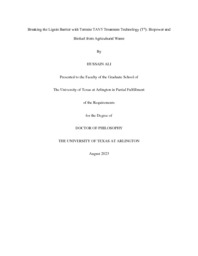| dc.description.abstract | Bioenergy obtained from anaerobic digestion of lignocellulose biomass is one of the promising candidates to help move towards a fossil fuel free future. Agriculture waste has up to 90% lignocellulose content, and the eight leading US crops produce over 500 million tons of residue each year. Unfortunately, lignin is resistant to microbial attack under low oxygen conditions which normally occur in anaerobic digesters, and it often shields lignocellulose components (cellulose and hemicellulose) from decomposition as well. Traditional physical/chemical methods for destroying lignin are typically costly due to energy and chemical requirements and can create toxic intermediates (Rahimi et al., 2020).
Termites are commonly known for their ability to degrade wood, which contains high levels of lignin; microorganisms present in the hindgut of termites are responsible decomposition of lignin in wood. TAV5 (Termite Associated Verrucomicrobia) is the fastest-growing microorganism isolated from the hindgut of the Reticulitermes flavipes termite, the most widespread subterranean termite in North America. Its genome contains genes associated with methylotrophic competency which code for enzymes that structurally modify lignin (Kotak et al., 2015). TAV5 has been found to degrade lignin in anaerobic conditions, which is quite unique since most of the pathways for biologically degrading lignin are aerobic. The overall goal of our research is to use TAV5 to destroy lignin and boost methane production from agriculture waste. Specific objectives are:
1. To determine optimal conditions for efficiently growing TAV5 in large volumes for field seeding of waste.
2. To determine the optimal addition of TAV5 to enhance methane production from agricultural wastes.
3. To conduct life-cycle environmental and economic assessments of biogas produced from agricultural waste using T4 Technology, compared to baseline technologies (biogas produced without T4 Technology and fossil fuels).
To accomplish the first objective, lab tests were conducted to find growth of TAV5 at different temperatures. Afterwards TAV5 was grown aerobically and anaerobically, and growth curves were developed and verified by using the cell count procedure. To accomplish the second objective, batch-scale reactors (125 mL) with four kinds of agricultural waste (rice straw, corn stover, rice husk and wheat straw) were used to determine the optimal ratios of TAV5 to anaerobic digester (AD) microorganisms to decompose waste and produce methane. Based on the results from batch-scale tests, life cycle analyses were conducted. POWER Tool was used to calculate costs and emissions associated with all the phases of life cycle. Estimates were based on a 20-year life of digester and 2% interest rate was used for cost analysis.
It was found that TAV5 shows limited growth over 37oC and grows more quickly in aerobic conditions, which are less costly. Batch reactors showed that the optimal ratio between TAV5 and WRRF sludge is 0.3 for corn stover and rice straw, 0.2 for wheat straw and 0.6 for rice husk. A higher ratio of TAV5 to WRRF sludge was needed for rice husk, which could be because it has a higher lignin content compared to other wastes used in this research, or possibly because rice husk was not ground, whereas the other waste streams were ground to have smaller particle size. No correlation was found between the lignin values of the other wastes and the TAV5 ratio, nor between the lignin values and the increase in methane production. Life cycle showed that the revenue generated by extra electricity production more than offsets the cost of growing TAV5. Rice straw showed the highest avoided cost due to higher increase in methane generation, whereas wheat straw showed the lowest increase in methane generation, thus lower avoided cost. Seeding digesters with TAV5 reduced emissions of carbon dioxide and criteria pollutant (NOx, SO2) emissions, since the increased biogas production could be used to produce cleaner electricity than the average electricity from the power grid. However, VOC emissions increased because biogas itself has a high VOC content (around 50% methane). Rice straw showed the highest reduction in NOx, PM, SO2 and CO2 emissions because it generates the highest amount of methane, which in turn produces more clean electricity. Overall, the results show that seeding existing farm digesters with TAV5 will result in higher revenues and lower emissions, making the agriculture sector more sustainable. | |


